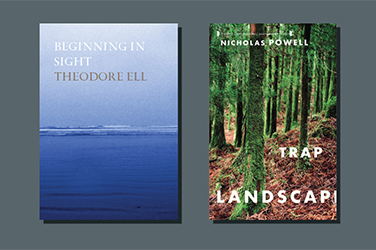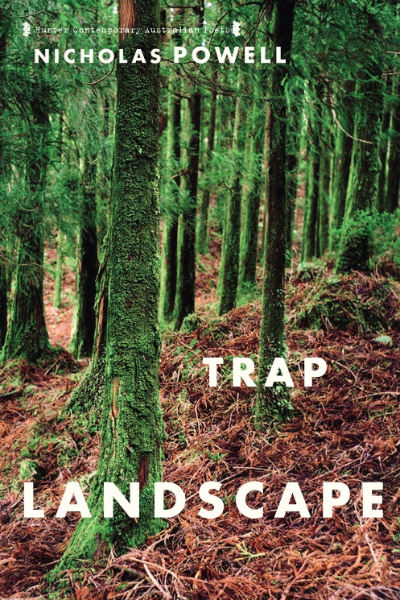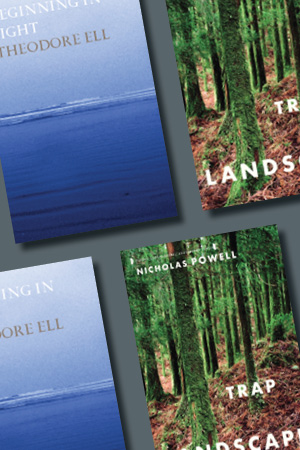
- Free Article: No
- Contents Category: Poetry
- Review Article: Yes
- Article Title: Labours of disruption
- Article Subtitle: Two bold poetry collections
- Online Only: No
- Custom Highlight Text:
One of the many life-challenging things that poetry can do is to prise open unexpected spaces and take us somewhere entirely unanticipated, whether it be in terms of how we live, how we understand the world, or how we link the fabric of textual utterance with that of our lived experience. These two new poetry collections set about this labour of disruption in very different ways, demonstrating some of the pathways available between poet and reader.
- Featured Image (400px * 250px):

- Alt Tag (Featured Image): Rose Lucas reviews 'Beginning in Sight' by Theodore Ell and 'Trap Landscape' by Nicholas Powell
- Book 1 Title: Beginning in Sight
- Book 1 Biblio: Recent Work Press, $19.95 pb, 72 pp
- Book 2 Title: Trap Landscape
- Book 2 Biblio: Hunter Publishers, $24.95 pb, 88 pp
- Book 2 Cover Small (400 x 600):

- Book 2 Cover (800 x 1200):

- Book 2 Cover Path (no longer required): images/ABR_Digitising_2022/Sep_2022/Trap Landscape Nicholas Powell.jpg
Beginning in Sight is Theodore Ell’s début poetry collection. A Calibre Prize winner in 2021 for his essay about the 2020 explosion in Beirut, Ell ranges across place and time with the white light of clarity. As the opening lines of the poem ‘Molecules’ suggest, it is a clarity that is distilled from a nuanced flow of metaphor and association:
Storms have been holding off – wind-shy, turned away,
barred at the ranges – through multiplying summers.Evenings still slip under an early shadow
that we recognize – there was no outrunning …
The reader is invited to lean into an unfolding of images, to be lead across the open territory of the dash with all its possibilities for what remains unarticulated.
In the poem ‘Sojourners’, Ell uses the first-person voice of someone infected with disease to take us across the ‘endless stroke’ of ‘swell’ to a place of quarantine. Line by line, evocative phrase by phrase, the reader follows through this surreal yet visceral experience of fear and dislocation:
… Quayside
and forest bluffs quaked at our first steps, turned usflimsy as medicine in phials. Through starched days,
long passage. Rumours in whitewashed wards, inklingsof blood in caught breath, the sudden empty beds
where a propped head lay only yesterday.
While suggestive of the early twentieth century of the Spanish Influenza, this poem also inevitably speaks to contemporary experiences of contagion and isolation and to the re-engagements with both mortality and communitas which it has brought. ‘Those whom life turns against have never loved it / as now’: the tremulous imagery of a poem such as this reminds us again of the precarity and the preciousness of a necessarily limited experience and of the human tenacity to find a way through. The compression and startle of some of the images and associations throughout Ell’s work draw the reader into a heightened alertness to what is and what might yet be possible.
The longer sequence ‘Verges’ brings us to ‘brinks’ of various kinds – those places where what may appear stable and sure give way to something not yet clear or defined. As a place of transition, the verge is a place on an edge, where what lies ahead or beyond might signify loss or danger, but also the possibilities of the new. The verges in this poem range from a dizzying high-speed car ride – ‘We’re away … we sneer over, throttle and sheet, skewered / for huge yelling moments’ – to the view of a gear-laden cyclist in the rear-vision mirror ‘wavering left, back left, at each rightward tilt;’ and to the ‘detour’ in memory that leads to places that can’t be spoken: ‘her quiet shrug. / The empty thoroughfares. There is no telling.’
Ell’s poetry brings us repeatedly to this interstitial space, where what is difficult might be confronted and where change might be embraced: ‘The curb to pause upon, skirting blown wreckage – / drift to ease the passing, the moving over.’ We can look forward to seeing the unfolding of this exciting new poetic.
Nicholas Powell’s first collection, Water Mirrors, won the Thomas Shapcott Poetry Prize in 2011. His new book, Trap Landscape, scrambles expectations of poetry and the ways in which poetry might make its meaning. This is a poetic of surprising juxtapositions that continually disrupts any neat linear or lyrical flow. The question it poses is therefore fundamental to the art of poetry: in opening up perception and challenging previous modes of understanding the world, does the poem provide access to new, perhaps more appropriate maps of meaning, or does it tip us into fragmentation? Or is the landscape of poetic language a kind of wasteland where such longed-for patterning is revealed as mirage, an endless deflection of meaning?
The opening poem, ‘Establishing Shot’ does indeed identify this poetic space of radical disruption and dislocation:
Descent by plastic parachute, running about
the garden in a way that flattens the plants.
[…]
The baby was shy and did not make friendswith strangers. That cannot be solved with a dictionary,
in a single room in a hospital, songs, or hair.They hung said thesaurus from a tree and shot it.
Kindly direct me to a chemist.
Powell’s poetic deconstructs the logic of the metaphor – that one thing can point meaningfully to another in a process of elucidation. In postmodernist terms, the reader is sent on a helter-skelter quest for what seems always elusive: can these piecemeal observations of life, knowable only through the refractions of the linguistic text, be ‘shored’ into a settled meaning, as T.S. Eliot might have hoped in The Waste Land, or are they at best only the playful banter of hollow signifiers? Perhaps this is the nature of the ‘trap’ – that we meander through the landscapes of experience and of language expecting – or at least hoping for – coherence, only to realise that we have wandered off the verge and into uncharted territory. As in the poem ‘Long Camera’, this can be an atavistically dangerous activity:
Camera and subject rigid with max
opening width of jaws
so a shallow depth requires an axe
or saw to dislodge, less you act.
The image and the threat of the axe appear again in the prose poetry sequence ‘Figures in Waiting’. In this poem, lineation and enjambment – so often poetic strategies that might point to moments of coherence – are left behind and the search for the ‘I’ gives way to the simulacra, the violence of the inauthentic:
A light burp lets out a large TV. Before life, the constant operation, a first incision without end. Touché, library. That we leap until replaced by someone I looks exactly like, corridor and all. Let the spider, spiders, roam, for we might matter in water. Drifting axe, stop in horror for this imposter. Water feature, drop from my hands.
In the poem ‘Open Pit’, we peer from a plane to see ‘cubist paddocks approaching Paris’. The cubist metaphor is potentially a useful one here: when the artist / poet looks at the world, rendering that process with the various tools of their trade, it refracts into the particular, the endless point of view. Is the art of the poem able to reassemble what falls into such shining and particulate matter, or can it only mirror that Babel-like fall?
Ah, there’s the question.



Comments powered by CComment